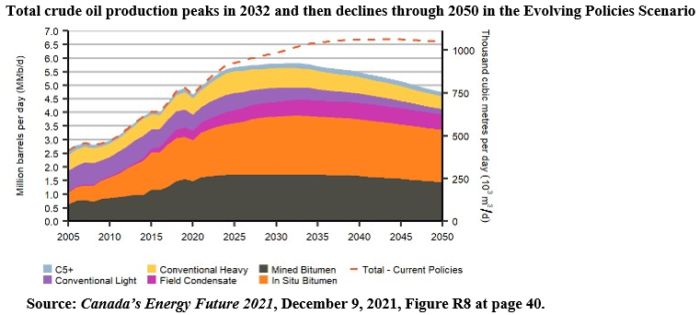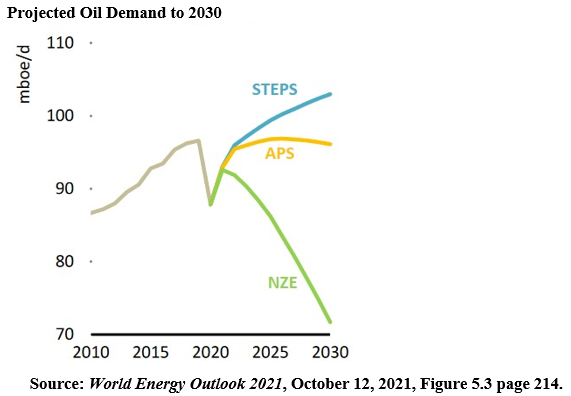On December 9, 2021, the Canada Energy Regulator (CER) released its Canada’s Energy Future 2021 (CER 2021) report, showing the expected trajectory of Canada’s future oil and gas production up to 2050. The CER has published two new scenarios.
The CER’s new “Evolving Policies Scenario”, which assumes the world will adopt “steadily more ambitious climate policies”, shows Canada’s oil production will continue growing until 2032, when it is projected to peak at 5.8 million bpd, a 19% increase above 2019. It projects that after 2032 Canada’s oil production will begin to slowly decline to 4.8 million bpd by 2050 (about 2% less than it was in 2019). Canada’s oil production shows no significant reduction over the next 30 years. The CER 2021 report gives this succinct summary:
From 2019 to 2032, crude oil production increases 19%. Between 2032 and 2050 production decreases by 19%.
— Canada’s Energy Future 2021, December 9, 2021, page 40
The CER’s more ambitious “Current Policies” scenario projects that Canada’s total oil production will continue to increase to 2044 when it peaks at 6.7 million bpd, an increase of 1.8 million bpd above the 2019 level. The report explains that this scenario assumes that “energy and climate policies that are currently in place” around the world remain unchanged. The CER’s projections are depicted in this graph published in the report:

The upper dotted red line represents Canada’s oil production to 2050 based on the “Current Policies Scenario”. The lower gray line depicts the “Evolving Policies Scenario”, peaking at 5.8 million bpd in 2032.
Yet this planned increase in Canada’s oil production, and the government’s stated intentions to maintain our current high levels of oil production to 2050, is incompatible with any of the scenarios and studies developed by leading international bodies that have examined the magnitude of the deep reductions in global oil production needed to stay within the 1.5°C warming threshold or the 2°C limit.
On May 18, 2021, the International Energy Agency (IEA) warned in its report Net-Zero by 2050: A Roadmap for the Global Energy Sector that to give us a realistic chance of keeping the increased warming of the earth’s atmosphere to less than 1.5°C, global oil consumption must decline 50% below the 2019 level by 2040. That would require cutting oil use worldwide from 98 million bpd (the 2019 level) down to 44 million bpd within the next 20 years. To stay within the 1.5°C temperature threshold, oil consumption worldwide must decline to 24 million bpd by 2050. The new IEA study calls for an immediate halt to any further expansion of global oil production.
The IEA’s “Net-Zero by 2050” Scenario requires that to stay on a pathway to 1.5°C global oil production must by 2030 decline 25% below the 2019 level. Canada’s plan is to continue increasing our oil production to 2032 (a projected 19% increase).
The complete divide between the present intentions of our governments and what human beings need to do within the next nine years is shown in this graph published in the IEA’s World Energy Outlook 2021 report on October 12, 2021:

The top blue line of the above graph (“STEPS”) depicts the IEA’s most recent projection indicating the rising pathway of global oil production between now and 2030, based on the current plans of Canada and the world’s other oil producing countries. The sharply declining green line (“NZE”) shows the magnitude of the cuts in overall world oil production needed by 2030 to give us a 50-50 chance of being able to limit global heating to less than 1.5°C.
On October 20, 2021, the UN Environmental Programme and the Stockholm Environmental Institute released their Production Gap Report 2021, which confirms the tragic disconnect between the existing plans of the world’s major oil producing countries (including Canada) to continue the expansion of global oil production and the desperate need to start reductions. The purpose of the report is “to quantify the discrepancy between the global levels of fossil fuel production implied by governments’ plans and projections and the levels consistent with the Paris Agreement goals (namely limiting warming to well below 2°C and pursuing efforts to limit the temperature increase to 1.5°C).” The difference is the “production gap”.
The report’s overall conclusion is that “the world’s governments plan to produce more than twice the amount of fossil fuels in 2030 than would be consistent with limiting warming to 1.5°C”. In the specific case of oil production, it states:
Nations are, in aggregate, planning on producing around 40 million barrels per day (Mb/d) more oil than would be consistent with the median 1.5°C pathway in 2030 (with a range of 26-56 Mb/d). This excess is roughly equivalent to half of current global oil production.
— Production Gap Report, October 20, 2021, p. 15-16
In recent years, Canada has ranked as the world 4th largest oil producer, and the 3rd largest oil exporter. We export 80% of our oil production.
This paper, addressed to the Member of Parliament for Vancouver Quadra (where I have lived for 35 years), takes a close look at Canada’s promised climate policies and explains why any honest plan that is truly aligned with meeting our Paris Agreement commitment of limiting global temperature rise to 1.5°C above pre-industrial levels must incorporate a plan to substantially reduce Canada’s oil production level by 2030 and achieve deeper reductions by 2040 in the order of 50% below the 2019 level.
- Read the paper: 10 Questions for Joyce Murray, Member of Parliament for Vancouver Quadra, Regarding the Continued Expansion of Canada’s Oil Production and the Unforgiving Deadline For Deep Emissions Reductions The Emissions Implications (opens as a PDF in your web browser)
updated February 4, 2022